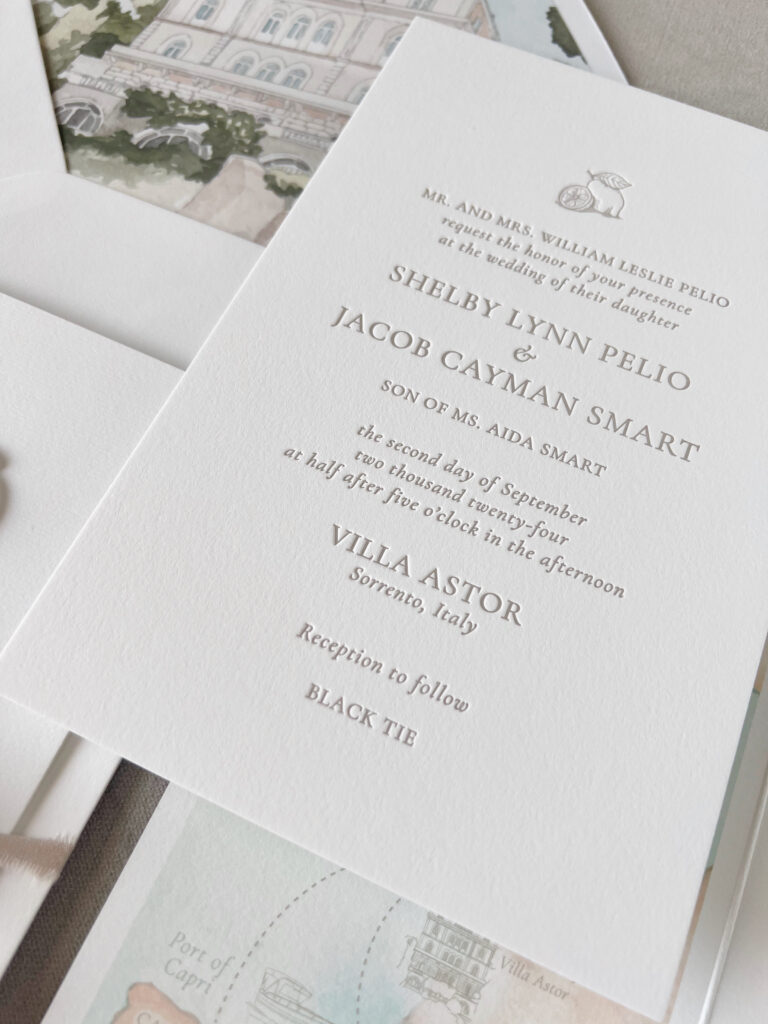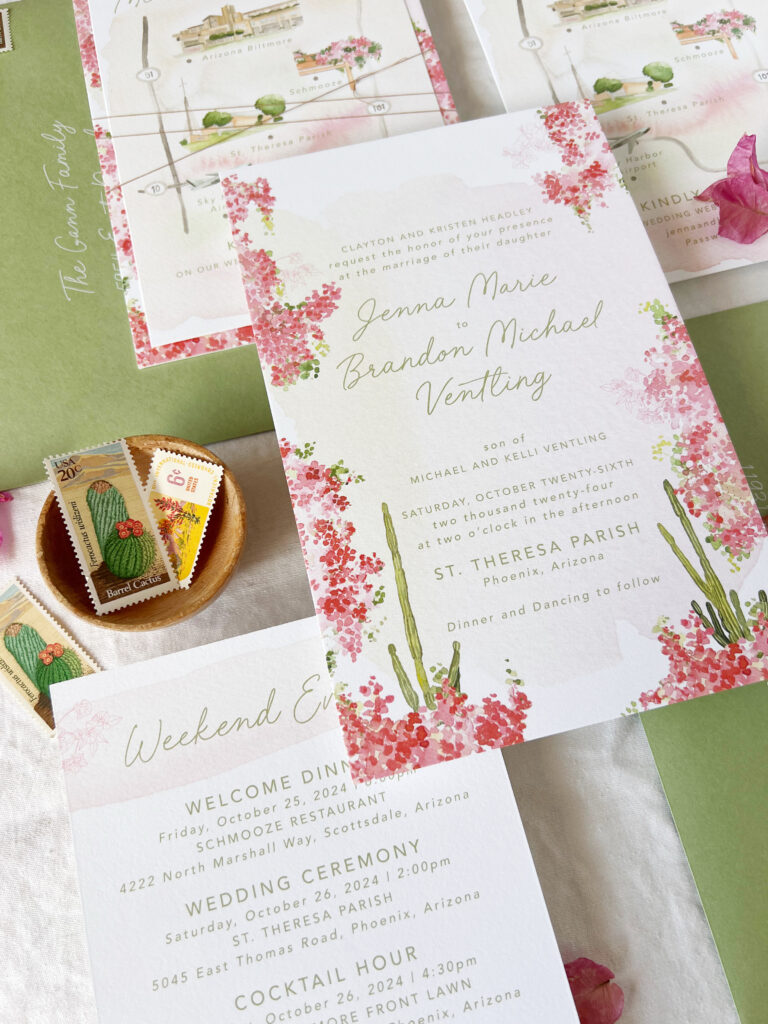When it comes to creating your wedding invitations, the printing method we choose plays a key role in setting the tone of your big day. Whether you’re dreaming of a classic, timeless design or a modern, minimalist look, understanding the differences between letterpress, foil stamping, and digital printing can help you achieve the perfect results. Today, we will take a closer look at these popular printing techniques and how they can be combined to elevate your wedding stationery.
Letterpress Printing: Timeless Elegance and Texture

Letterpress printing has been around for centuries and never gets old! If I am being honest, this is my favorite print method of them all. It’s a method where ink is pressed deeply into the paper using custom-made plates, creating a pillowy, debossed effect. The result is a luxurious and timeless aesthetic, perfect for couples who want their invitations to exude sophistication and craftsmanship.
Best suited for: Traditional, vintage, and elegant designs with minimal color. Letterpress requires a canvas of thick cotton cardstock or handmade paper. Letterpress printing is ideal for invitations with few colors, clean typography, or hand-drawn illustrations.
Pros:
- Adds depth and texture to the paper
- Luxurious and sophisticated look
- Best for designs with simple details and limited colors
Cons:
- More expensive than digital printing
- Limited number of colors on each design (each color requires a separate press)
Perfect Pairing: Letterpress works beautifully with high-quality cotton cardstock or handmade paper, giving the invitation a luxurious feel. It’s especially effective with soft, muted tones or single-color designs that highlight the beauty of the texture. I love combining letterpress printing with digitally printed watercolor illustrations!
Foil Stamping: Shimmer and Shine

Foil stamping adds metallic accents—such as gold, silver, or rose gold, just to name a few—by applying heat and pressure to transfer the foil onto the paper. This process gives your invitations a beautiful, reflective quality that instantly elevates the overall design.
Best suited for: Glamorous, modern, or formal weddings where a touch of sparkle or richness is desired. Foil stamping is ideal for bold fonts, monograms, or design elements that you want to stand out.
Pros:
- Eye-catching metallic finish
- Works well on all colors of paper including dark or colored paper
- Adds a luxurious and glamorous feel
Cons:
- More expensive than digital printing
- May not be suitable for very detailed or fine designs
Perfect Pairing: Foil stamping can be used on dark-colored papers or in combination with letterpress for a sophisticated blend of texture and shine. A foil-stamped monogram or names paired with letterpress typography can add both tactile and visual interest.
Digital Printing: Versatile and Budget-Friendly

Digital printing is a modern method that uses inkjet or laser technology to print directly onto the paper. Unlike letterpress and foil stamping, digital printing is flat and doesn’t provide the same texture, but it’s ideal for designs that require multiple colors, or intricate details. This is the most cost-effective option, especially for couples working within a budget.
Best suited for: Modern, whimsical, or colorful designs where intricate patterns, watercolor illustrations, or multiple colors are key to the design. Digital printing is also great for photo save-the-dates or invitation suites with many pieces.
Pros:
- Affordable and fast
- Ideal for complex or multi-colored designs
- Can print on a wide variety of paper types
Cons:
- No tactile quality or depth
- Lacks the luxury feel of letterpress or foil stamping
Perfect Pairing: Digital printing works well with illustrations, vibrant colors, and intricate details. White ink digital printing is also a great way to add beautiful contrast on dark papers.
Combining Print Methods for a Unique Design
For couples who want to elevate their invitations even further, combining multiple print techniques is a fantastic way to create a one-of-a-kind design that stands out.
Here are a few ways you can mix print methods to achieve a stunning result:
- Letterpress + Foil Stamping: Create a luxurious blend by using letterpress for the main text and foil stamping for key elements like names or monograms. The deep impression of the letterpress paired with foil will give your invitations a rich and tactile finish.
- Digital Printing + Foil Stamping: For a modern twist, use digital printing for colorful illustrations or background patterns and accentuate the invitation with foil-stamped details, like metallic accents on florals or text. This combination is budget-friendly but still offers that wow factor.
- Letterpress + Digital Printing: You can also combine letterpress and digital printing to add depth to a colorful or detailed design. Use digital printing for detailed artwork or watercolor backgrounds, and letterpress for the key text or focal elements to give it that extra luxury quality.
Final Thoughts
Choosing the right printing method for your wedding invitations depends on your style, budget, and the overall vision for your special day. Whether you’re drawn to the timeless, texture of letterpress, the richness of foil stamping, or the versatility of digital printing, each option offers a unique way to make your invitations unforgettable. And for couples who can’t decide, combining print methods can provide the best of both worlds, creating a truly one-of-a-kind invitation suite that reflects your personality and sets the tone for your wedding.
Let’s start designing!
Be the first to comment